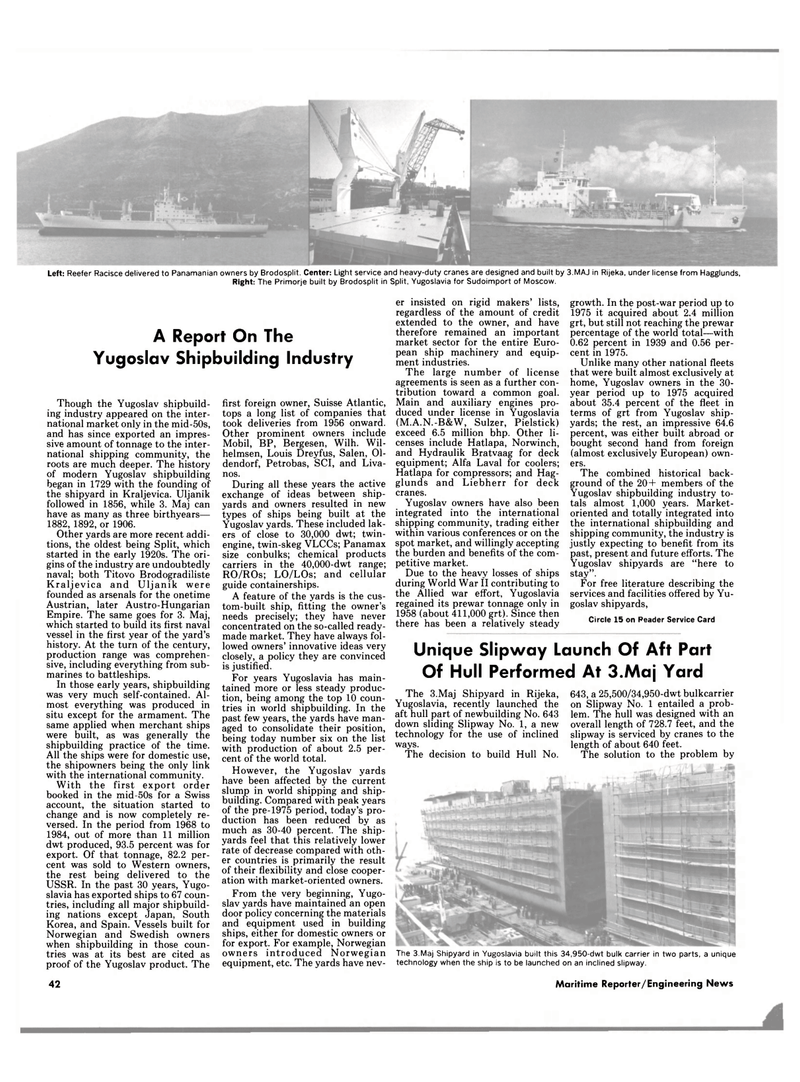
Page 40: of Maritime Reporter Magazine (May 1986)
Read this page in Pdf, Flash or Html5 edition of May 1986 Maritime Reporter Magazine
Left: Reefer Racisce delivered to Panamanian owners by Brodosplit. Center: Light service and heavy-duty cranes are designed and built by 3.MAJ in Rijeka, under license from Hagglunds,
Right: The Primorje built by Brodosplit in Split, Yugoslavia for Sudoimport of Moscow.
A Report On The
Yugoslav Shipbuilding Industry
Though the Yugoslav shipbuild- ing industry appeared on the inter- national market only in the mid-50s, and has since exported an impres- sive amount of tonnage to the inter- national shipping community, the roots are much deeper. The history of modern Yugoslav shipbuilding began in 1729 with the founding of the shipyard in Kraljevica. Uljanik followed in 1856, while 3. Maj can have as many as three birthyears— 1882, 1892, or 1906.
Other yards are more recent addi- tions, the oldest being Split, which started in the early 1920s. The ori- gins of the industry are undoubtedly naval; both Titovo Brodogradiliste
Kraljevica and Uljanik were founded as arsenals for the onetime
Austrian, later Austro-Hungarian
Empire. The same goes for 3. Maj, which started to build its first naval vessel in the first year of the yard's history. At the turn of the century, production range was comprehen- sive, including everything from sub- marines to battleships.
In those early years, shipbuilding was very much self-contained. Al- most everything was produced in situ except for the armament. The same applied when merchant ships were built, as was generally the shipbuilding practice of the time.
All the ships were for domestic use, the shipowners being the only link with the international community.
With the first export order booked in the mid-50s for a Swiss account, the situation started to change and is now completely re- versed. In the period from 1968 to 1984, out of more than 11 million dwt produced, 93.5 percent was for export. Of that tonnage, 82.2 per- cent was sold to Western owners, the rest being delivered to the
USSR. In the past 30 years, Yugo- slavia has exported ships to 67 coun- tries, including all major shipbuild- ing nations except Japan, South
Korea, and Spain. Vessels built for
Norwegian and Swedish owners when shipbuilding in those coun- tries was at its best are cited as proof of the Yugoslav product. The first foreign owner, Suisse Atlantic, tops a long list of companies that took deliveries from 1956 onward.
Other prominent owners include
Mobil, BP, Bergesen, Wilh. Wil- helmsen, Louis Dreyfus, Salen, 01- dendorf, Petrobas, SCI, and Liva- nos.
During all these years the active exchange of ideas between ship- yards and owners resulted in new types of ships being built at the
Yugoslav yards. These included lak- ers of close to 30,000 dwt; twin- engine, twin-skeg VLCCs; Panamax size conbulks; chemical products carriers in the 40,000-dwt range;
RO/ROs; LO/LOs; and cellular guide containerships.
A feature of the yards is the cus- tom-built ship, fitting the owner's needs precisely; they have never concentrated on the so-called ready- made market. They have always fol- lowed owners' innovative ideas very closely, a policy they are convinced is justified.
For years Yugoslavia has main- tained more or less steady produc- tion, being among the top 10 coun- tries in world shipbuilding. In the past few years, the yards have man- aged to consolidate their position, being today number six on the list with production of about 2.5 per- cent of the world total.
However, the Yugoslav yards have been affected by the current slump in world shipping and ship- building. Compared with peak years of the pre-1975 period, today's pro- duction has been reduced by as much as 30-40 percent. The ship- yards feel that this relatively lower rate of decrease compared with oth- er countries is primarily the result of their flexibility and close cooper- ation with market-oriented owners.
From the very beginning, Yugo- slav yards have maintained an open door policy concerning the materials and equipment used in building ships, either for domestic owners or for export. For example, Norwegian owners introduced Norwegian equipment, etc. The yards have nev- er insisted on rigid makers' lists, regardless of the amount of credit extended to the owner, and have therefore remained an important market sector for the entire Euro- pean ship machinery and equip- ment industries.
The large number of license agreements is seen as a further con- tribution toward a common goal.
Main and auxiliary engines pro- duced under license in Yugoslavia (M.A.N.-B&W, Sulzer, Pielstick) exceed 6.5 million bhp. Other li- censes include Hatlapa, Norwinch, and Hydraulik Bratvaag for deck equipment; Alfa Laval for coolers;
Hatlapa for compressors; and Hag- glunds and Liebherr for deck cranes.
Yugoslav owners have also been integrated into the international shipping community, trading either within various conferences or on the spot market, and willingly accepting the burden and benefits of the com- petitive market.
Due to the heavy losses of ships during World War II contributing to the Allied war effort, Yugoslavia regained its prewar tonnage only in 1958 (about 411,000 grt). Since then there has been a relatively steady growth. In the post-war period up to 1975 it acquired about 2.4 million grt, but still not reaching the prewar percentage of the world total—with 0.62 percent in 1939 and 0.56 per- cent in 1975.
Unlike many other national fleets that were built almost exclusively at home, Yugoslav owners in the 30- year period up to 1975 acquired about 35.4 percent of the fleet in terms of grt from Yugoslav ship- yards; the rest, an impressive 64.6 percent, was either built abroad or bought second hand from foreign (almost exclusively European) own- ers.
The combined historical back- ground of the 20+ members of the
Yugoslav shipbuilding industry to- tals almost 1,000 years. Market- oriented and totally integrated into the international shipbuilding and shipping community, the industry is justly expecting to benefit from its past, present and future efforts. The
Yugoslav shipyards are "here to stay".
For free literature describing the services and facilities offered by Yu- goslav shipyards,
Circle 15 on Reader Service Card
Unique Slipway Launch Of Aft Part
Of Hull Performed At 3.Maj Yard
The 3.Maj Shipyard in Rijeka,
Yugoslavia, recently launched the aft hull part of newbuilding No. 643 down sliding Slipway No. 1, a new technology for the use of inclined ways.
The decision to build Hull No. 643, a 25,500/34,950-dwt bulkcarrier on Slipway No. 1 entailed a prob- lem. The hull was designed with an overall length of 728.7 feet, and the slipway is serviced by cranes to the length of about 640 feet.
The solution to the problem by
The 3.Maj Shipyard in Yugoslavia built this 34,950-dwt bulk carrier in two parts, a unique technology when the ship is to be launched on an inclined slipway. 42 Maritime Reporter/Engineering News

 39
39

 41
41
